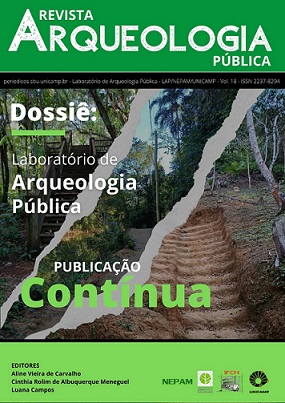Abstract
What I propose in this paper is a contribution to Archaeogaming, understanding that digital games can indeed be analyzed from an archaeological perspective, owing nothing to the other categories of artifacts that we, as scientists, created and listed during the development of our discipline. I will start by arguing that time is relative, a human construction that, in fact, interferes with archaeological science. Then, I will conceptualize “artifact” to argue that digital games can also be analyzed archaeologically. Finally, I will present a case study based on a methodological proposal using a videogame cartridge: artifact that I chose for this text.
References
CHIADO, Marcus Vinicius Garret. 1983+1984: quando os videogames chegaram. Marcus Vinicius Garret Chiado, São Paulo, 2016.
CHIAROTTI, Tiziano Mamede. O patrimônio histórico edificado como um artefato arqueológico: uma fonte alternativa de informações. Habitus, 3(2), p. 301-319, 2005.
DEETZ, James. The dynamics of stylistic change in Arikara ceramics. Illinois Studies in Anthropology, n. 4, 1965.
DEETZ, James. In small things forgotten: an archaeology of early American life. Anchor, New York, 1996.
FORTE, Maurizio (ed.). Cyber-Archaeology. BAR, v. 2177, Oxford, Archaeopress, 2010.
GLEICK, James. A informação. Uma história, uma teoria, uma enxurrada. Tradução de Augusto Calil. São Paulo, Companhia das Letras, 2013.
LE GOFF, Jacques. A história deve ser dividida em pedaços? Tradução de Nícia Adan Bonatti. São Paulo, Editora Unesp, 2015.
LÉVY, Pierre. O que é o virtual? Tradução de Paulo Neves. São Paulo, Editora 34, 1996.
MARTIRE, Alex. Ciberarqueologia em Vipasca: o uso de tecnologias para a reconstrução-simulação interativa arqueológica. São Paulo: Universidade de São Paulo, 2017. (Tese de Doutorado. Museu de Arqueologia e Etnologia) – Universidade de São Paulo, São Paulo, 2017.
MILLER, Daniel. Trecos, troços e coisas: estudos antropológicos sobre a cultura material. Tradução de Renato Aguiar. Rio de Janeiro, Zahar, 2013.
ORSER, Charles E. Introdução à arqueologia histórica. Tradução de Pedro Paulo Abreu Funari. Belo Horizonte: Oficina de Livros, 1992.
RABARDEL, P. 1995. Les hommes et les technologies: approaches cognitive des instruments contemporains. Paris, A. Colin, 1995.
REILLY, Paul. Towards a virtual archaeology. In: LOCKYEAR, Kris e RAHTZ, Sebastian (eds.). Computer Applications in Archaeology 1990. Oxford, British Archaeological Reports (Int. Series 565), p. 133-139, 1990.
REINHARD, Andrew. Archaeogaming: An Introduction to Archaeology in and of Video Games. Oxford, Berghahn Books, 2018.
SCHAAN, Denise Pahl. Uma janela para a história pré-colonial da Amazônia: olhando além – e apesar – das fases e tradições. Boletim do Museu Paraense Emilio Goeldi, 2(1), 77-89, 2007.
SCHIFFER, Michael B. Archaeological context and systemic context. American Antiquity, 37(2), p. 156-165, 1972.
TRIGGER, Bruce Graham. História do pensamento arqueológico. Tradução de Ordep Trindade Serra. 2ª ed. São Paulo, Odysseus, 2002.
ZARANKIN, Andrés; SENATORE, Maria Ximena. Historias de un pasado en blanco: arqueología histórica antártica. Belo Horizonte, Argumentum, 2007.

This work is licensed under a Creative Commons Attribution-NonCommercial 4.0 International License.
Copyright (c) 2023 Revista Arqueologia Pública


